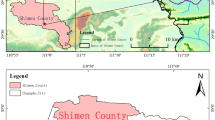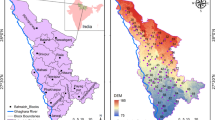Abstract
High arsenic concentrations are common in the water and soils in Tibet. In this study, arsenic concentrations were found to be below detection limits in natural river water, although the high background concentrations of HCO3− and the pH all favor arsenic release. Lake water had the highest arsenic concentrations due to intense evaporation. The impact of mining on arsenic release was assessed using a mixing model composed of three end-members: KS02 (a post-mining sample), R07 (a river water sample), and S12 (spring water that contains arsenic). The results indicated that mining operations are likely responsible for a small proportion (2.0%) of direct release of arsenic from deep thermal water, and that most arsenic was released by desorption from Fe oxyhydroxides. The mixing model also revealed that so far, mining operations have accelerated carbonate dissolution, but have not led to arsenopyrite oxidation. Therefore, HCO3− concentrations increased during mining, which along with the pH (> 7.0), led to desorption of arsenic from Fe oxyhydroxide.
Zusammenfassung
Hohe Arsenkonzentrationen sind in den Gewässern und Böden Tibets weit verbreitet. In dieser Studie wurden in natürlichem Flusswasser Arsenkonzentrationen unter der Nachweisgrenze gefunden, obwohl hohe Hintergrundkonzentrationen von Hydrogenkarbonat und der pH-Wert die Mobilisierung von Arsen an sich befördern. Seewasser hatte wegen der Verdunstung die höchsten Arsenkonzentrationen. Der Einfluss von Bergbau wurde mit einem Mischungsmodell mit drei Komponenten untersucht: KS02 (eine Probe aus der Bergbaufolgelandschaft), R07 (eine Flusswasserrobe) und S12 (Quellwasser, das Arsen enthält). Die Ergebnisse zeigten, dass die Bergbauaktivitäten wahrscheinlich für einen kleinen Anteil (2,0%) der direkten Arsenmobilisierung aus tiefem Thermalwasser verantwortlich sind und dass das meiste Arsen aus der Desorption von Eisenoxihydroxiden stammt. Das Mischungsmodell zeigte außerdem, dass der Bergbau die Auflösung von Karbonaten beschleunigt, aber nicht zur Oxidation von Arsenopyrit geführt hat. Daher stieg während der Bergbauaktivitäten die Konzentration von Hydrogenkarbonat, was zusammen mit dem pH-Wert (>7,0) zur Desorption von Arsen von Eisenoxihydroxiden führte.
Resumen
Las altas concentraciones de arsénico son comunes en el agua y los suelos del Tíbet. En este estudio, se encontró que las concentraciones de arsénico estaban por debajo de los límites de detección en el agua natural de los ríos, aunque las altas concentraciones de fondo de HCO3- y el pH favorecen la liberación de arsénico. El agua del lago tenía las mayores concentraciones de arsénico debido a la intensa evaporación. El impacto de la minería en la liberación de arsénico se evaluó utilizando un modelo de mezclas compuesto por tres miembros finales: KS02 (una muestra posterior a la minería), R07 (una muestra de agua de río) y S12 (agua de manantial que contiene arsénico). Los resultados indicaron que las operaciones de minería son probablemente responsables de una pequeña proporción (2,0%) de la liberación directa de arsénico de las aguas termales profundas y que la mayor parte del arsénico se liberó por desorción oxihidróxidos de hierro. El modelo de mezclas también reveló que hasta ahora las operaciones mineras han acelerado la disolución del carbonato, pero no han generado oxidación de arsenopirita. Por consiguiente, las concentraciones de HCO3- aumentaron durante la explotación minera, lo que, junto con el pH (>7,0), dio lugar a la desorción del arsénico de los óxidos de Fe.
抽象
西藏地区水和土壤的砷含量普遍较高。在研究中,虽然HCO-3 高浓度背景和pH值都利于砷释放,但是天然河水砷浓度却低于检测限。强烈蒸发作用使湖水砷浓度最高。利用三个端元组成的混合模型评价了采矿对砷释放的影响,三个端元水样是KS02(开采后水样)、R07(河水水样)和S12(含砷泉水)。结果表明,采矿可能只引起了深层温泉水砷直接释放的小部分(2.0%),大部分砷由氢氧化铁解吸过程释放。混合模型还表明,目前采矿加速了碳酸盐溶解,并未直接导致砷黄铁矿(毒砂)氧化。因此,采矿期间,HCO-3 浓度增加和pH(>7.0)升高导致砷从氢氧化铁中解吸释出。







Similar content being viewed by others
References
Alvarez-Cruz JL, Garrido-Hoyos SE (2019) Effect of the mole ratio of Mn/Fe composites on arsenic (V) adsorption. Sci Total Environ 668:47–55. https://doi.org/10.1016/j.scitotenv.2019.02.234
Amstätter K (2009) Microbial iron reduction influenced by humic acids and redox transformation of arsenic by reactive iron minerals. Ph. D. thesis, Eberhard Karls Universität, Tübingen. https://nbn-resolving.de/urn:nbn:de:bsz:21-opus-39286
Appelo CA, Mj VDW, Tournassat C, Charlet L (2002) Surface complexation of ferrous iron and carbonate on ferrihydrite and the mobilization of arsenic. Environ Sci Technol 36(14):3096–3103
Bauer M, Blodau C (2006) Mobilization of arsenic by dissolved organic matter from iron oxides, soils and sediments. Sci Total Environ 354:179–190
Bidone E, Castilhos Z, Cesar R, Santos MC, Sierpe R, Ferreira M (2016) Hydrogeochemistry of arsenic pollution in watersheds influenced by gold mining activities in Paracatu (Minas Gerais State, Brazil). Environ Sci Pollut Res Int 23:8546–8555
DeVore CL, Rodriguez-Freire L, Mehdi-Ali A, Ducheneaux C, Artyushkov K, Zhou Z, Latta DE, Lueth VW, Gonzales M, LewisCerrato JJM (2019) Effect of bicarbonate and phosphate on arsenic release from mining-impacted sediments in the Cheyenne River watershed, South Dakota, USA. Environ Sci-Proc Imp 21:456–468
Dixit S, Hering JG (2003) Comparison of arsenic(V) and arsenic(III) sorption onto iron oxide minerals: implications for arsenic mobility. Environ Sci Technol 37(18):4182–4189
Gao T (2017) Studies on the adsorption and redox behaviors between arsenic-containing pyrites and As (III, V). M.S. thesis, Huazhong Agricultural Univ [in Chinese]
Gao X, Wang Y, Hu Q, Su C (2011) Effects of anion competitive adsorption on arsenic enrichment in groundwater. Environ Lett 46:471–479
Gu H, Ma F, Guo J, Zhao H, Lu R, Liu G (2017) A spatial mixing model to assess groundwater dynamics affected by mining in a coastal fractured aquifer, China. Mine Water Environ 37:405–420. https://doi.org/10.1007/s10230-017-0505-x
Islam FS, Gault AG, Boothman C, Polya DA, Charnock JM, Chatterjee D, Lloyd JR (2004) Role of metal-reducing bacteria in arsenic release from Bengal delta sediments. Nature 430:68–71
Jiang JQ, Ashekuzzaman SM, Hargreaves JSJ, Mcfarlane AR, Badruzzaman ABM, Tarek MH (2015) Removal of Arsenic (III) from groundwater applying a reusable Mg-Fe-Cl layered double hydroxide. J Chem Technol Biot 90:1160–1166
Laaksoharju M, Gascoyne M, Gurban I (2008) Understanding groundwater chemistry using mixing models. Appl Geochem 23(7):1921–1940
Laaksoharju M, Skårman C, Skårman E (1999) Multivariate mixing and mass balance (M3) calculations, a new tool for decoding hydrogeochemical information. Appl Geochem 14:861–871
Lim JW, Lee E, Moon HS, Lee KK (2013) Integrated investigation of seawater intrusion around oil storage caverns in a coastal fractured aquifer using hydrogeochemical and isotopic data. J Hydrol 486:202–210
Masscheleyn PH, DelaunePatrick RDWH Jr (1991) Effect of redox potential and pH on arsenic speciation and solubility in a contaminated soil. Environ Sci Technol 25:1414–1419
Mcarthur JM (1999) Arsenic poisoning in the Ganges delta. Nature 401:546–547
Pantsarkallio M, Manninen PKG (1997) Specification of mobile arsenic in soil samples s a function of pH. Sci Total Environ 204:193–200
Qiu G, Gao T, Hong J, Tan W, Fan L, Zheng L (2017) Mechanisms of arsenic-containing pyrite oxidation by aqueous arsenate under anoxic conditions. Geochim Cosmochim Acta 217:306–319
Roussel C, Néel C, Bril H (2000) Minerals controlling arsenic and lead solubility in an abandoned gold mine tailings. Sci Total Environ 263:209–219
Rouwane A, Rabiet M, Grybos M, Bernard G, Guibaud G (2016) Effects of NO3− and PO43− on the release of geogenic arsenic and antimony in agricultural wetland soil: a field and laboratory approach. Environ Sci Poll Res 23:4714–4728
Sako A, Bamba O, Gordio A (2016) Hydrogeochemical processes controlling groundwater quality around Bomboré gold mineralized zone, central Burkina Faso. J Geochem Explor 170:58–71
Sheng T, Baig SA, Hu Y, Xue X, Xu X (2014) Development, characterization and evaluation of iron-coated honeycomb briquette cinders for the removal of As(V) from aqueous solutions. Arab J Chem 7:27–36
Smith AH, Lingas EO, Rahman M (1999) Contamination of drinking-water by arsenic in Bangladesh: a public health emergency. Bull World Health Organ 78:1093–1103
Tamoto S, Tabelin CB, Igarashi T, Ito M, Hiroyoshi N (2015) Short and long term release mechanisms of arsenic, selenium and boron from a tunnel-excavated sedimentary rock under in situ conditions. J Contam Hydrol 175–176:60–71
Tian Y, Yu C, Luo K, Zha X, Wu J, Zhang X, Ni R (2015) Hydrochemical characteristics and element contents of natural waters in Tibet, China. J Geograph Sci 25:669–686. https://doi.org/10.1007/s11442-015-1195-6
Tian Y, Yu C, Zha X, Wu J, Gao X, Feng C, Luo K (2016) Distribution and potential health risks of arsenic, selenium, and fluorine in natural waters in Tibet. China Water 8:568. https://doi.org/10.3390/w8120568
Tu S, Ma LQ (2003) Interactive effects of pH, arsenic and phosphorus on uptake of As and P and growth of the arsenic hyperaccumulator Pteris vittata L. under hydroponic conditions. Environ Exp Bot 50:243–251
Wei B et al (2017) An investigation of the health effects caused by exposure to arsenic from drinking water and coal combustion: arsenic exposure and metabolism. Environ Sci Pollut Res Int 24:1–8
Wen R, Tian LD, Weng YB, Liu ZF, Zhao ZP (2012) The altitude effect of δ 18 O in precipitation and river water in the Southern Himalayas. Sci Bull 57:1693–1698
Xiao J, Maoyong HE, Xiao Y, Jin Z (2012) Progress of geochemical application of boron isotope. Marine Geol Front 28:20–33
Zhu J, Baig SA, Sheng T, Lou Z, Wang Z, Xu X (2015) Fe3O4 and MnO2 assembled on honeycomb briquette cinders (HBC) for arsenic removal from aqueous solutions. J Hazard Mater 286:220–228
Acknowledgements
This study was also supported by the Natural Science Foundation of China (projects 41907174 and 41502245), and the China Geological Survey (projects DD20190524 and DD20189210).
Author information
Authors and Affiliations
Corresponding author
Rights and permissions
About this article
Cite this article
Gu, H., Ni, H., Wang, Y. et al. Hydrogeochemical Characteristics and Impact of Arsenic Released from a Gold Deposit in Tibet. Mine Water Environ 39, 746–757 (2020). https://doi.org/10.1007/s10230-020-00732-4
Received:
Accepted:
Published:
Issue Date:
DOI: https://doi.org/10.1007/s10230-020-00732-4




